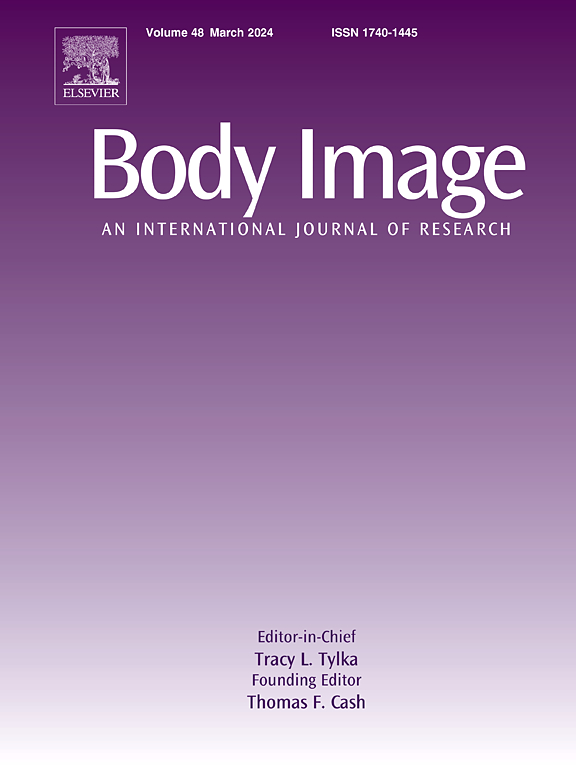孕妇身体形象的三方影响模型检验
IF 5.4
1区 心理学
Q1 PSYCHIATRY
引用次数: 0
摘要
三方影响模型为理解由心理过程介导的社会文化压力如何导致身体不满意提供了一个强有力的框架。本研究的目的是在孕妇中验证这一模型,在孕妇中,媒体、同伴、家庭和重要他人的压力通过外表比较和瘦理想内化与身体不满有关。我们预测,所有社会文化的影响来源将与身体不满直接或间接相关。参与者(309名孕妇,平均年龄:32.9岁)完成了一份问卷,包括社会文化对外表的态度问卷- 4r,身体-外表比较量表和身体形状问卷-14。通过通径分析,将媒体压力、同伴压力、家庭压力和重要他人压力分别作为外貌比较、瘦型理想内化和身体不满意的预测因素。我们发现只有媒体和家庭压力与身体不满有直接关系。此外,媒体压力和重要他人压力通过外表比较和瘦理想内化对身体不满的间接影响都是显著的。同伴压力(即感知到的期望和评价性评论)与身体不满没有直接或间接的联系。总的来说,这些发现提供了关于社会文化压力,特别是来自媒体、家庭和重要他人的压力,在塑造孕妇对身体不满方面所起作用的信息。该研究强调了医疗保健专业人员解决社会审美标准对孕妇心理健康和身体形象的影响的重要性。医疗保健提供者可考虑将心理评估纳入产前护理,以确定有身体不满加剧风险的妇女。本文章由计算机程序翻译,如有差异,请以英文原文为准。
Testing the tripartite influence model on body image among pregnant women
The Tripartite Influence Model provides a robust framework for understanding how sociocultural pressures, mediated by psychological processes, contribute to body dissatisfaction. The present study aimed to test this model among pregnant women, in which media, peers, family and significant others pressures were associated with body dissatisfaction via physical appearance comparison and thin-ideal internalization. We predicted that all sociocultural sources of influence would be associated with body dissatisfaction both directly and indirectly. Participants (309 pregnant women, mean-age: 32.9 years) completed a questionnaire containing the Sociocultural Attitudes Towards Appearance Questionnaire-4R, the Physical-Appearance Comparison Scale, and the Body-Shape Questionnaire-14. A path analysis was performed in which media, peers, family and significant others pressures were posited as predictors of the physical appearance comparison, thin-ideal internalization and body dissatisfaction, respectively. We found that only media and family pressures were directly related to body dissatisfaction. Moreover, the indirect effect of both media and significant others pressures on body dissatisfaction through physical appearance comparison and thin-ideal internalization was significant. Peer pressures (i.e., perceived expectations and evaluative comments) were not associated with body dissatisfaction either directly or indirectly. Overall, these findings provide information about the role that sociocultural pressures, particularly those from media, family and significant others, play in shaping body dissatisfaction among pregnant women. The study highlighted the importance for healthcare professionals to address the impact of societal beauty ideals on pregnant women’s mental health and body image. Healthcare providers might consider incorporating psychological assessments into prenatal care to identify women at risk of heightened body dissatisfaction.
求助全文
通过发布文献求助,成功后即可免费获取论文全文。
去求助
来源期刊

Body Image
Multiple-
CiteScore
8.70
自引率
28.80%
发文量
174
期刊介绍:
Body Image is an international, peer-reviewed journal that publishes high-quality, scientific articles on body image and human physical appearance. Body Image is a multi-faceted concept that refers to persons perceptions and attitudes about their own body, particularly but not exclusively its appearance. The journal invites contributions from a broad range of disciplines-psychological science, other social and behavioral sciences, and medical and health sciences. The journal publishes original research articles, brief research reports, theoretical and review papers, and science-based practitioner reports of interest. Dissertation abstracts are also published online, and the journal gives an annual award for the best doctoral dissertation in this field.
 求助内容:
求助内容: 应助结果提醒方式:
应助结果提醒方式:


